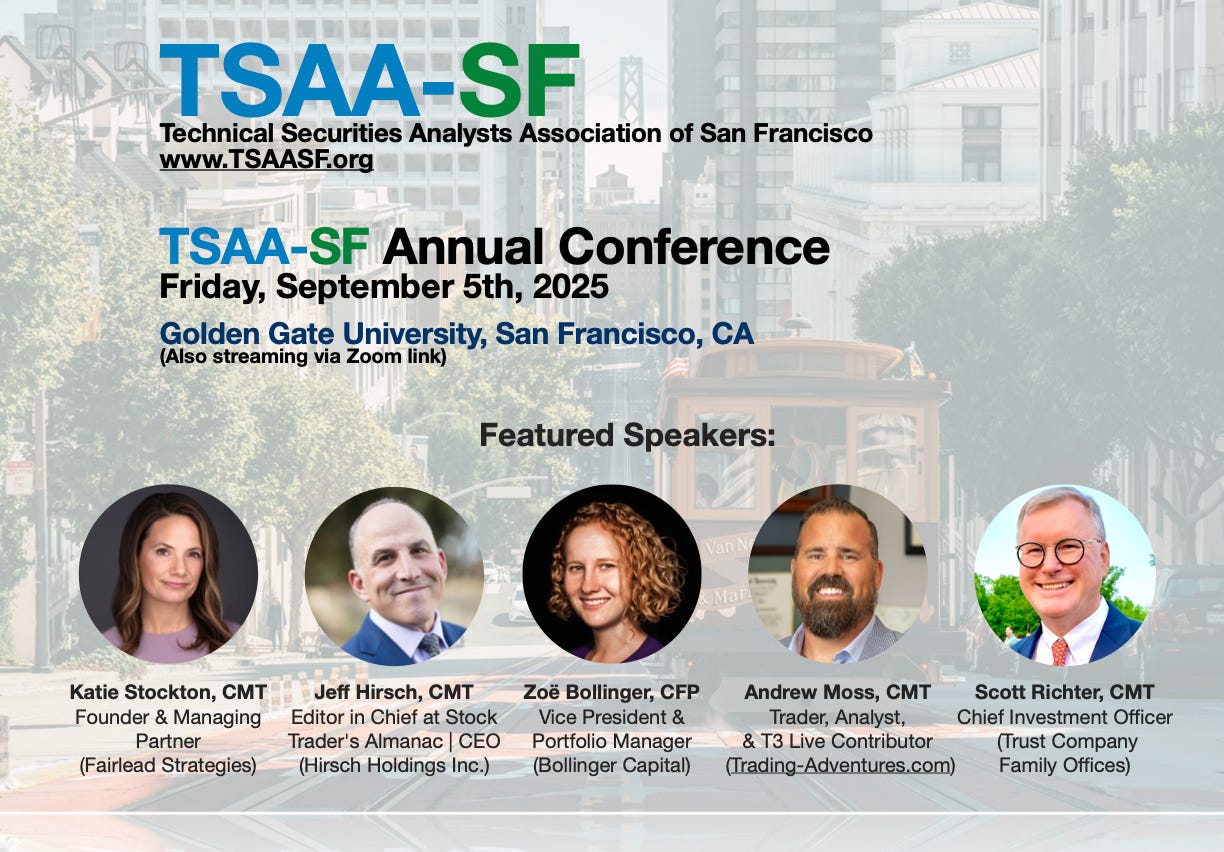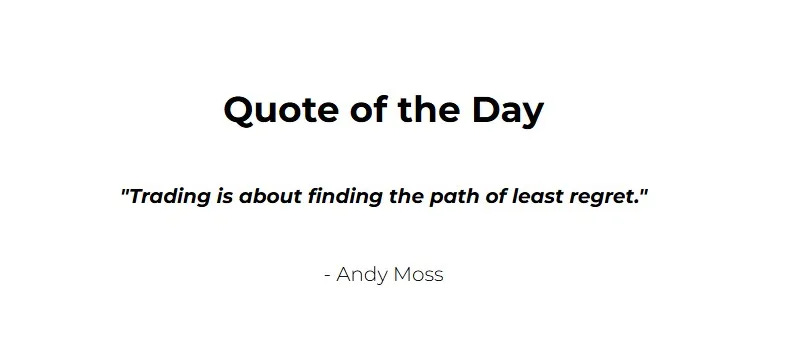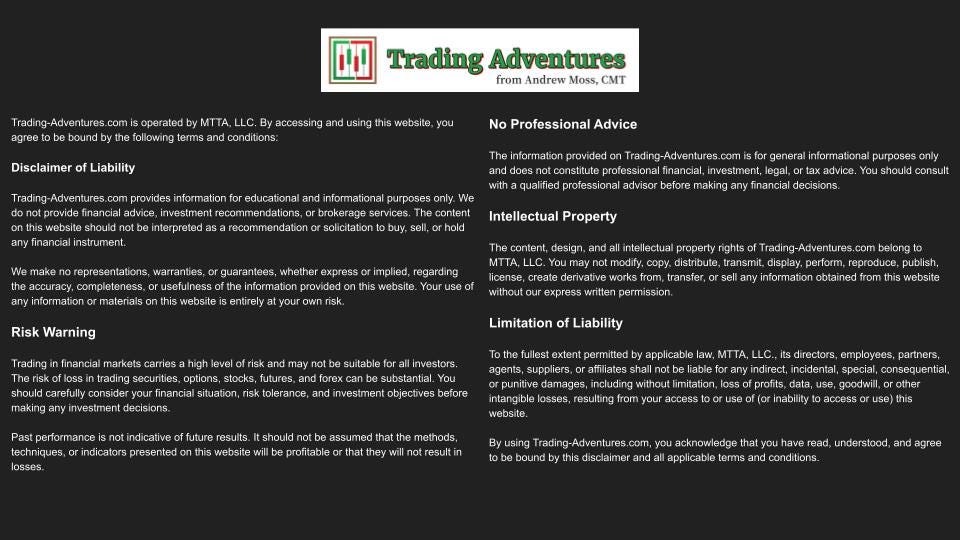Discipline, Cycles, and Context
Takeaways from the 2025 TSAA-SF Conference on building edge with structure, seasonality, and self-awareness.
This past Friday, I had the privilege of speaking at the TSAA-SF Annual Conference at Golden Gate University in San Francisco.
It was a full-circle moment—sharing ideas with peers and mentors, listening to sharp minds across the field, and walking away with renewed clarity on what really drives edge in the markets. The event brought together seasoned technicians, educators, and traders for a deep dive into what continues to matter most in markets: structure, discipline, and context.
Across keynotes, panels, and breakout sessions, one shared theme echoed clearly: consistent edge comes from consistent behavior, not predictions.
Lead with Risk, Let Price Confirm
Katie Stockton — Fairlead Strategies
Katie opened the day with a powerful reminder: technical analysis is a risk-management discipline, not a prediction engine.
Her framework begins top-down—index internals, sector rotation, and individual setups—using a consistent toolkit: 20/50-day MAs, Ichimoku Cloud, MACD, and stochastics. But the emphasis was less on the tools and more on how you use them.
Notably:
The S&P was flagged as in both a cyclical and secular uptrend, with near-term pullback risk
Small caps (IWM) forming a potential cup-and-handle structure
Growth cooling tactically; value showing signs of mean reversion
Defensive sectors oversold on relative strength basis
“We are primarily focused on risk management… price contains all the information.”
Katie’s emphasis on confirmation over anticipation set the tone for the day.
Jeff Hirsch — Stock Trader’s Almanac
Jeff followed with a walk through the four-year presidential cycle and decades of seasonal patterns.
His message: don’t predict—prepare. Use cycles to frame exposure, not force trades.
Key takeaways:
“Best Six Months” (Nov–Apr) pattern, with MACD overlays
Within-month effects: early inflows, mid-month strength, and October’s reversal history
Current environment is the “sweet spot” of the four-year cycle: midterm Q4 through pre-election Q4
“The sweet spot of the four-year cycle runs from the midterm low through the pre-election year.”
Jeff also made the case for a continued secular “super boom,” driven by peace, disinflation, and paradigm-shifting tech like AI—echoing past analogs such as the microprocessor in the ’80s.
The Process Is the Edge
Andrew Moss — Trading Psychology and Execution
In my session, I focused on the internal game—the intersection of discipline, structure, and psychology.
“You don’t trade the market. You trade your beliefs about the market.” —Van Tharp
We broke it down practically:
Define R before entering—know where you’re wrong
Size positions relative to R and equity
Build a system that fits your beliefs, timeframes, and emotional wiring
Journal more than just P&L. Track thoughts, actions, behaviors, mistakes, and overall system adherence—not just outcomes
I also shared a principle that’s helped shape my own approach—featured as Quote of the Day in The Chart Report, thanks to Pat Dunuwila.
Execution under pressure is the differentiator. The edge isn’t the setup—it’s sticking to your system when the heat’s on.
The Panel: Seasonality, Simplicity, Structure
Moderated by Pat Dunuwila (The Chart Report)
Panelists: Andrew Moss, Chris Antonio, John Zazenski, and Jeff Hirsch
The panel dove into practical application:
Breadth vs. mega-cap concentration
Growth-to-value rotation signals
How much weight to give seasonality
AI’s role (assistive, not decisive)
Risk framing via regime filters: MA slope, MACD histogram, anchored VWAP
Each panelist returned to a common point: there are no bonus points for complexity. Edge comes from clarity, preparation, and adaptation.
System Design at Scale
Zoe Bollinger — Discretion to Automation
Zoe presented her workflow for building rule-based, repeatable trading systems—shifting from discretionary decision-making to systematic execution.
Her focus:
Translating discretionary edges into codified rules
Using scoring models to combine momentum, trend, and overbought/oversold filters
Keeping systems lean—avoiding indicator overload and redundancy
It was a standout presentation that gave the room a practical lens on automation and scalability.
Fireside Wisdom
Scott Richter — Fireside Chat with Brett Villaume
Scott closed the day with a look back over a career managing large portfolios—yet his message was surprisingly simple:
Stay close to the tape
Use clear entry structures
Know when to scale down or step aside
Review consistently—process over performance
“Principles persist. Tools evolve.”
The conversation with Brett reminded everyone that whether you’re managing institutional capital or trading solo, durability comes from discipline.
Practical Playbook
Weekly Regime Check:
Trend: Monthly/Weekly MAs, MACD slope
Seasonality and election-cycle phase
Internals: % above 50-day, A/D line, sentiment, VIX posture
Setup Criteria:
Long bias: price above cloud and rising 21/50-day moving average
Improving RS vs. benchmark
Confirmation from structure and momentum
Risk and Position Sizing:
Sizing should be systematic — scalable based on setup quality and structure fit
Risk more when the setup aligns with your process, not based on emotion
Review Loop:
Grade trades by adherence to plan, not just P&L
Journal execution, thoughts, and context
Review expectancy by setup and refine accordingly
Final Takeaway
Technical analysis works best as a risk framework—not a prediction engine. That idea ran through every chart, conversation, and keynote I heard in San Francisco.
With Gratitude
Huge thanks to Nick Chong, Mike Jones, Rick Leonhart, Brett Villaume, everyone involved with TSAA-SF, the attendees, and fellow speakers. And special thanks to Pat Dunuwila for moderating the panel and asking sharp questions throughout. And to Golden Gate University for hosting.
The event was energizing, insightful, and exceptionally well organized. TSAA-SF continues to elevate the field of technical analysis—with community, integrity, and a deep respect for the craft.
I’ll be carrying lessons and memories from this weekend into every session ahead.
Link Index —
TSAA-SF —
Fairlead Strategies (Katie Stockton, CMT) —
https://www.fairleadstrategies.com
Stock Trader’s Almanac (Jeff Hirsch) —
https://www.stocktradersalmanac.com
Trading-Adventures (Andrew Moss, CMT) —
https://trading-adventures.com
The Chart Report (Pat Dunuwila, CMT) —
https://www.thechartreport.com
Bollinger Capital Management (Zoe Bollinger, CFP) —
https://www.bollingercapital.com/
Trust Company Family Offices (Scott Richter, CMT) —
Golden Gate University —
Looking For More?
Elevate Your Trading Adventure Even Further With These Offerings.
EpicTrades Options Newsletter
Real-time trade ideas and insights, providing actionable trading insights focusing on options trades with short-term horizons, aiming to capitalize on weekly market movements.
The approach includes detailed reasoning for trades, specific options, and profit targets. It focuses on quick gains with a minimal time commitment from subscribers.
The Inner Circle
The Inner Circle is a Virtual Trading Floor (VTF) at T3 Live. I’ve been working and trading with this group since 2022. You may have noticed the logo in the watermarks on my charts.
Founded by David Prince and led by him, Rick March, and Kira Turner, the Inner Circle is a community of elite traders, including hedge fund managers, family office heads, corporate executives, financial advisors, and even professional poker players.
Fundamental, Macro, and Technical Analysis all combine to find and discuss the best opportunities in current markets.
The Disclosures
***This is NOT financial advice. This is NOT a recommendation to buy, sell, or trade any security. The content presented here is intended for educational purposes only.








